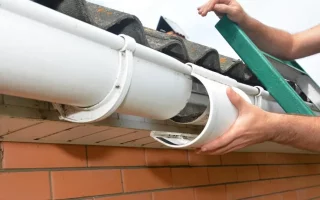Is your toilet tank giving you a headache with its constant leak? Don’t worry; we’ve got you covered! A leaking toilet tank can be a frustrating problem, but the good news is that it’s usually fixable. We’ll guide you through fixing a leaking toilet tank step-by-step. From assessing the issue to turning off the water and replacing faulty components, we’ll help you get your bathroom back in order.
Assess the problem
First, grab a flashlight and carefully inspect the area around the toilet tank. Look for any visible cracks or signs of water dripping from connections or valves. Sometimes, a loose or damaged supply line can be the culprit behind a leaking tank. Next, check if the leak is coming from the bottom of the tank itself. This could indicate a problem with the flush valve seal or bolts securing it to the tank. If you notice water pooling at the bottom or hear hissing sounds when not in use, these are telltale signs that something isn’t right. Another possible source of leakage could be a faulty fill valve assembly. After flushing, check for any drips or excessive running water inside your toilet bowl. If left unaddressed, a malfunctioning fill valve can lead to continuous refilling and subsequent overflowing. Remember to inspect any flapper valves inside your toilet tank, as they can deteriorate over time and cause leaks. Conduct simple dye tests to ensure they’re correctly sealing off openings when not in use. By thoroughly assessing all these potential issues, you can narrow down what’s causing your leaking toilet tank woes. Once you have identified the problem, it’s time to move on to fixing it step-by-step!
Turn off the water to the toilet.
A critical step in fixing a leaking toilet tank is to turn off the water supply. This will prevent further leaks or potential flooding while you work on the repairs. To do this, locate the shut-off valve, which is usually located near the bottom of your toilet tank or along the wall behind it.
To turn off the water, turn the valve clockwise until it stops. If you have trouble locating or turning off the valve, don’t hesitate to call a professional plumber for assistance. Once you’ve turned off the water supply, flush your toilet to drain any remaining water from the tank. You can also use a sponge or towel to soak up any excess water that may be left. By turning off and draining the water from your toilet tank, you’re taking an essential step toward fixing that annoying leak. Now, let’s move on and inspect those tank components!
Empty the toilet tank.
One crucial step in fixing a leaking toilet tank is to empty the tank. This ensures that you can work on the components without any water interference. You must locate and turn off the water supply valve connected to the toilet to do this. Once you’ve located the valve, turn it clockwise to shut off the water flow into the tank. This will prevent any new water from entering while you’re working on fixing the leak. Next, flush the toilet once or twice to remove as much water as possible from the tank. You can also use an old towel or sponge to soak up any remaining water to empty the tank. By taking these steps and adequately emptying your toilet tank, you’ll be well-prepared to inspect and replace faulty components that may be causing leaks. Stay tuned for more tips on how to fix a leaking toilet!
Inspect the tank components.
Inspecting the tank components is a crucial step in fixing a leaking toilet. It allows you to identify the faulty part and determine whether it can be repaired or replaced. So, let’s get started!
First, remove the lid of the toilet tank carefully. Take a close look at all the different parts inside. Check for any cracks, leaks, or signs of wear and tear. Next, examine the flush valve and flapper. Make sure they are properly aligned and functioning correctly. Look for any debris or mineral buildup that could be causing a blockage or preventing them from sealing tightly. Remember to inspect the fill valve as well. Ensure it is not damaged and water flows smoothly into the tank. If you notice any leaks or irregularities, it may need to be adjusted or replaced. Take a moment to check all the seals around bolts, gaskets, and connections in the tank. Look for any signs of deterioration or leakage. Give everything a good cleaning! Use a cloth or sponge to remove all components’ dirt, grime, or mineral deposits. Now that we have inspected all the components thoroughly let’s move on to replacing any faulty parts we found during our examination.
Replace the faulty component.
Now that you have assessed the problem and turned off the water to your leaking toilet tank, it’s time to replace the faulty component. This step is crucial in fixing the leak and ensuring your toilet functions appropriately. Carefully remove the old component from the tank. It could be a worn-out flapper valve, a cracked fill valve, or a faulty flush handle. Whatever it may be, identify and inspect it closely before proceeding. Next, head to your local hardware store or plumbing supply shop to purchase a replacement part. Ensure that you get the right size and type of component for your specific toilet model. Once you have obtained the new part, follow the manufacturer’s instructions for installation. This usually involves disconnecting any connections or bolts holding the old component and attaching the new one securely. Take your time during this process to avoid any mistakes or further damage. Double-check all connections are tight and secure before moving on. After successfully replacing the faulty component, reassemble your toilet tank by reversing any disassembling steps you took earlier. Make sure all parts fit together snugly without any gaps or leaks. Turn on the water supply valve slowly while watching for any signs of leakage. If everything looks good, allow your tank to refill completely before testing its functionality with a flush.
Put the tank back together.
Once you have successfully replaced the faulty component in your toilet tank, it’s time to put everything back together. This step is crucial in ensuring that your toilet functions appropriately and doesn’t continue to leak. Start by carefully placing the lid of the tank back in its position. Ensure it aligns perfectly with the base and sits securely without wobbling. Gently press down on all sides to ensure a snug fit. Next, reattach any bolts or screws that were removed during the disassembly process. Use a screwdriver or wrench to tighten them securely, but be careful not to overtighten as this can cause damage. Now is also an excellent time to check for cracks or leaks around the tank’s base. If you notice any issues, use some plumber’s tape or silicone caulk to seal them off and prevent further leakage. After securing all components, slowly turn on the water supply valve and allow the tank to refill. Keep an eye out for any signs of leaking, as this may indicate additional problems that need addressing.
Turn the water back on.
With the necessary steps taken to fix a leaking toilet tank, it’s time to turn the water back on. Slowly open the shut-off valve, allowing water to flow back into the tank. Watch for any signs of leakage or dripping as the tank refills. Once the tank is full, flush the toilet and observe its performance. If everything looks good and there are no more leaks, congratulations! You’ve successfully fixed your leaking toilet tank. Remember, regular maintenance and inspections can help prevent future issues with your toilet tank. It’s always a good idea to look for any signs of leaks or malfunctioning components so that you can address them promptly. Following these simple steps and being proactive about maintaining your toilet can save both water and money in the long run. So don’t let a leaking toilet tank go unnoticed – take action today!
If you need more clarification about tackling this task yourself or encounter any difficulties along the way, feel free to contact a professional plumber who can provide expert assistance.





